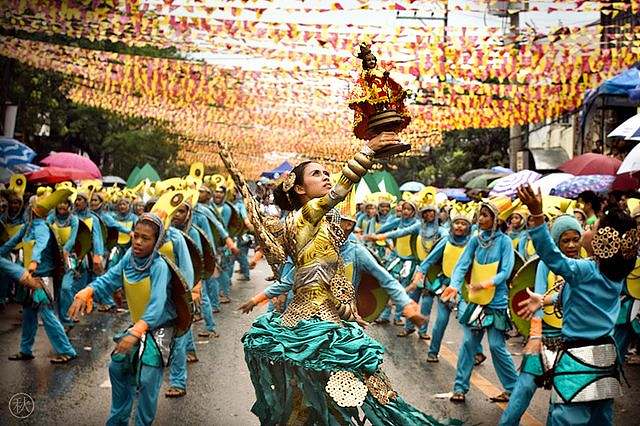Celebrating the Sinulog Festival
Dive into the heart of Cebu, Philippines, and discover the vibrant colors, spirited dances, and deep devotion of the Sinulog Festival, a spectacle of cultural and religious fervor.

| Short Description |
|---|
| Introduction to the Sinulog Festival |
| Background and Significance. Annual Celebration Dates |
| The Historical Roots of Sinulog |
| Pre-Colonial Beginnings. Pre-Colonial Beginnings |
| Cultural Significance and Traditions |
| Music and Instruments Used. Grand Parade and Street Dancing |
| Sinulog Festival Highlights |
| Religious Ceremonies and Activities. |
| Experiencing Sinulog: A Visitor’s Guide |
| How to Participate. Tips for First-Time Attendees |
| The Art and Craft of Sinulog |
| Costume Design and Symbolism. Float and Puppetry in the Parade |
| Sinulog Beyond the Festival |
| Year-Round Impact on Cebu. Educational and Community Outreach |
| Food and Festivities |
| Traditional Dishes and Delicacies. Traditional Dishes and Delicacies. |
| Sinulog Festival in the Digital Age |
| Social Media Influence. Virtual Celebrations and Future Prospects |
| Sinulog’s Contribution to Philippine Tourism |
| Economic Impact. Promoting Cultural Heritage. |
| Reflections on Sinulog: Personal Stories |
| Experiences from Locals. International Visitors’ Impressions. |
| Conclusion: The Enduring Spirit of Sinulog. Summary and Final Thoughts |
Celebrating the Sinulog Festival
The Sinulog Festival, held annually in Cebu City, Philippines, is a vibrant tapestry of history, culture, and faith. This grand celebration honors the Santo Niño, or the Holy Child Jesus, blending pre-colonial Filipino traditions with Catholic rituals. It’s a time when the streets of Cebu burst into life with rhythmic dances, colorful costumes, and the heartfelt chants of “Pit Senyor!” Let’s embark on a journey to explore the Sinulog Festival, from its historical roots to its modern-day splendor, offering insights and tips for those wishing to experience this extraordinary event firsthand.
Introduction to the Sinulog Festival
Background and Significance
The Sinulog Festival is more than just an annual event; it’s the heartbeat of Cebu’s culture and a testament to the Filipino people’s enduring faith. Every third Sunday of January, Cebu transforms into a kaleidoscope of colors, music, and dance, attracting visitors from around the globe. The festival commemorates the Filipino people’s pagan past and their acceptance of Christianity, represented by the Santo Niño statue given to Queen Juana by Ferdinand Magellan in 1521.
Annual Celebration Dates
Marking your calendar for the Sinulog Festival means setting aside the week leading up to the third Sunday of January. This period is filled with a plethora of activities, including religious ceremonies, cultural shows, and street parties, culminating in the grand parade.
The Historical Roots of Sinulog
- Pre-Colonial Beginnings
Long before the arrival of Spanish explorers, the indigenous people of the Philippine islands engaged in ritual dances to honor their deities and ancestors. The Sinulog dance, characterized by its two-step forward, one-step backward motion, mimics the movement of the Pahina River’s current and is believed to be a dance of worship.
- Spanish Influence and Catholic Integration
The introduction of Christianity marked a significant turning point in Filipino history. The Sinulog Festival, as it is known today, is a fusion of these pre-colonial traditions and the Christian faith, illustrating the seamless blend of the country’s indigenous and colonial histories.
Cultural Significance and Traditions
Dance Rituals and Costumes
At the heart of the Sinulog Festival are the dance rituals, performed by groups dressed in bright, elaborate costumes. These dances, accompanied by the sound of drums and native gongs, tell stories of faith, struggle, and thanksgiving, offering a glimpse into the Filipino spirit.
Music and Instruments Used
The music of Sinulog, with its infectious beats and rhythmic patterns, plays a crucial role in the festivities. Traditional instruments, such as drums, gongs, and bamboo flutes, create the festival’s signature sound, encouraging spectators to join in the celebration.
Sinulog Festival Highlights
Grand Parade and Street Dancing
The Sinulog Grand Parade is a spectacle of color and joy, featuring dancers, floats, and puppeteers who parade through the streets of Cebu City. This event showcases the creativity and artistry of the Cebuano people, with each contingent telling a unique story through dance.
Religious Ceremonies and Activities
Beyond the revelry, the Sinulog Festival is deeply rooted in religious devotion. Activities such as the fluvial procession, novena masses, and the reenactment of the Christianization of the Filipinos highlight the festival’s spiritual significance.
Experiencing Sinulog: A Visitor’s Guide
How to Participate
For those looking to experience Sinulog, it’s advisable to book accommodations well in advance and to be prepared for large crowds. Participating in the masses and joining the street parties are great ways to immerse yourself in the festival’s vibrant atmosphere.
Tips for First-Time Attendees
First-time attendees should prioritize safety and comfort, wearing appropriate clothing and staying hydrated. It’s also recommended to keep valuables secure and to have a plan for meeting points in case of separation from your group.
The Art and Craft of Sinulog
Costume Design and Symbolism
Sinulog costumes are a feast for the eyes, with their bright colors and intricate designs. Each costume tells a story, often reflecting the dancer’s region, historical influences, or religious devotion.
Float and Puppetry in the Parade
The floats and puppets that accompany the dancers are masterpieces of craftsmanship, representing scenes from Philippine history and folklore. These elements add depth and dimension to the Sinulog parade, making it a truly unforgettable experience.
Sinulog Beyond the Festival
Year-Round Impact on Cebu
The Sinulog Festival leaves a lasting impact on Cebu, boosting tourism and fostering a sense of community. It’s a time when the city showcases its culture, history, and hospitality to the world.
Educational and Community Outreach
The festival also serves as an educational tool, teaching younger generations about their heritage. Community outreach programs during Sinulog help to address social issues, demonstrating the festival’s role in promoting social awareness and responsibility.
Food and Festivities
Traditional Dishes and Delicacies
No festival is complete without food, and Sinulog is no exception. From street food to traditional Cebuano dishes, the festival offers a culinary adventure that reflects the region’s rich flavors and cooking traditions.
Nightlife and Social Gatherings
As the sun sets, Sinulog’s nightlife comes alive with concerts, parties, and gatherings. These events provide an opportunity for locals and visitors alike to mingle, celebrate, and enjoy the festive atmosphere.
Sinulog Festival in the Digital Age
- Social Media Influence
The rise of social media has transformed the Sinulog Festival, allowing it to reach a global audience. Participants share their experiences online, spreading the spirit of Sinulog far beyond the shores of the Philippines.
- Virtual Celebrations and Future Prospects
In recent years, virtual celebrations have become part of the Sinulog experience, ensuring that the festival’s message of faith, hope, and joy can be shared even in challenging times. As technology evolves, so too will the ways in which Sinulog is celebrated, promising a bright future for this beloved festival.
Sinulog’s Contribution to Philippine Tourism
Economic Impact
The Sinulog Festival significantly contributes to the Philippine economy, attracting tourists and generating revenue for local businesses. It’s a testament to the festival’s appeal and its role in promoting the Philippines as a vibrant, culturally rich destination.
Promoting Cultural Heritage
Sinulog plays a crucial role in preserving and promoting Filipino cultural heritage. By showcasing the country’s history, traditions, and artistic expressions, the festival helps to keep the Filipino spirit alive and vibrant for future generations.
Reflections on Sinulog: Personal Stories
Experiences from Locals
For many Cebuanos, Sinulog is a time of reflection, celebration, and renewal. Local residents share their stories of participating in the festival, highlighting the sense of unity and pride it brings to their community.
International Visitors’ Impressions
Visitors from around the world are often moved by the beauty and spirit of Sinulog. Their experiences underscore the festival’s universal appeal and its ability to connect people across cultures through the power of faith and festivity.
Conclusion: The Enduring Spirit of Sinulog
The Sinulog Festival is a vibrant celebration of faith, culture, and community. It stands as a symbol of the Filipino people’s resilience, creativity, and devotion. As we look back on the festival’s rich history and look forward to its future, one thing remains clear: the spirit of Sinulog continues to inspire and unite us all.
FAQs
What is the Sinulog Festival?
The Sinulog Festival is an annual cultural and religious festival held on the third Sunday of January in Cebu City, Philippines. It is celebrated in honor of the Santo Niño, or the Child Jesus, and commemorates the Filipino people’s pagan origin, their acceptance of Christianity, and their recognition of their heritage.
When is the Sinulog Festival celebrated?
The Sinulog Festival takes place every year on the third Sunday of January. The festival lasts for about a week, with various events and activities leading up to the main parade on Sunday.
What are the main events of the Sinulog Festival?
The main events include the Sinulog Grand Parade, a colorful, day-long procession featuring dancers in bright, elaborate costumes dancing to the rhythm of drums, trumpets, and native gongs. Other significant events are the Sinulog-based dance competition, the religious procession a day before the grand parade, and numerous street parties.
What does the word “Sinulog” mean?
“Sinulog” comes from the Cebuano word “sulog,” which means “like the flow of water.” It refers to the forward-backward step movement of the Sinulog dance, which mimics the Sulog river’s current.
How did the Sinulog Festival start?
The festival has its origins in the historical event in 1521 when Portuguese explorer Ferdinand Magellan arrived in the Philippines and presented the Santo Niño statue to the Rajah of Cebu as a baptismal gift. The Sinulog dance, believed to originate from the pagan culture of the natives, was later Christianized after the introduction of Christianity.
What is unique about the Sinulog Festival?
Sinulog is unique due to its blend of both cultural and religious aspects. It’s not just a street festival; it is deeply embedded in the religious faith of the Filipino people. The festival is also famous for its vibrant display of the rich cultural heritage of the Philippines through dance, music, and costumes.
How can someone participate in or experience the Sinulog Festival?
Yes, the festival is generally safe with increased security measures during the event. However, as with attending any large public gathering, it’s advisable to be cautious with personal belongings and stay aware of your surroundings.
